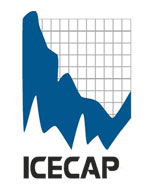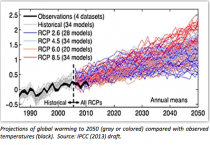Gore did the NBC rounds this week on the Today show with Matt Lauer and then on the equally empty-headed David Letterman to use Sandy and the Australian Cyclone Oswald which brought flooding and sea foam (not uncommon in tropical storms) to Australia as proof he was right after all. Of course the 20- foot sea level rise he predicted looks like will be more likely 7 inches by 2100. Instead of the studio crane he could have used the Manhattan Yellow pages to illustrate the effect in AIT. Lord Stern despite proclamations throughout Europe of concern that the greenhouse theory is failing - with a 16 year lack of warming that has the scientists ‘baffled’ in the words of the hard left enviro friendly Spiegel/Euro-Media said he was not alarmist enough.

Lord Stern now believes he should have been more 'blunt about threat to economies from temperature rises. Photograph: Sarah Lee for the Guardian
Lord Stern, author of the government-commissioned review on climate change that became the reference work for politicians and green campaigners, now says he underestimated the risks, and should have been more "blunt" about the threat posed to the economy by rising temperatures. What do Gore and Stern do when presented with the facts. They double down...much as was predicted in 'When Prophecies Fail".
In an interview at the World Economic Forum in Davos, Stern, who is now a crossbench peer, said: "Looking back, I underestimated the risks. The planet and the atmosphere seem to be absorbing less carbon than we expected, and emissions are rising pretty strongly. Some of the effects are coming through more quickly than we thought then."
The Stern review, published in 2006, pointed to a 75% chance that global temperatures would rise by between two and three degrees above the long-term average; he now believes we are "on track for something like four '. Had he known the way the situation would evolve, he says, "I think I would have been a bit more blunt. I would have been much more strong about the risks of a four - or five- degree rise."
He said some countries, including China, had now started to grasp the seriousness of the risks, but governments should now act forcefully to shift their economies towards less energy-intensive, more environmentally sustainable technologies.
"This is potentially so dangerous that we have to act strongly. Do we want to play Russian roulette with two bullets or one? These risks for many people are existential."
Stern said he backed the UK's Climate Change Act, which commits the government to ambitious carbon reduction targets. But he called for increased investment in greening the economy, saying: "It's a very exciting growth story."

David Cameron made much of his environmental credentials before the 2010 election, travelling to the Arctic to highlight his commitment to tackling global warming. But the coalition’s commitment to green policies has recently been questioned, amid scepticism among Tory backbenchers about the benefits of wind power, and the chancellor’s enthusiasm for exploiting Britain’s shale gas reserves.
Stern’s comments came as Jim Yong Kim, the new president of the World Bank, also at Davos, gave a grave warning about the risk of conflicts over natural resources should the forecast of a four-degree global increase above the historical average prove accurate.
“There will be water and food fights everywhere,” Kim said as he pledged to make tackling climate change a priority of his five-year term.
Kim said action was needed to create a carbon market, eliminate fossil-fuel subsidies and “green” the world’s 100 megacities, which are responsible for 60 to 70% of global emissions.
He added that the 2012 droughts in the US, which pushed up the price of wheat and maize, had led to the world’s poor eating less. For the first time, the bank president said, extreme weather had been attributed to man-made climate change. “People are starting to connect the dots. If they start to forget, I am there to remind them. We have to find climate-friendly ways of encouraging economic growth. The good news is we think they exist”.
Kim said there would be no solution to climate change without private sector involvement and urged companies to seize the opportunity to make profits: “There is a lot of money to be made in building the technologies and bending the arc of climate change.”
Spiegel has finally gotten around to conceding that global warming has ended, at least for the time being.
Yesterday Spiegel science journalist Axel Bojanowski published a piece called: Klimawandel: Forscher ratseln über Stillstand bei Erderwärmung (Climate change: scientists baffled by the stop in global warming).
We’ve been waiting for this admission a long time, and watching the media reaction is interesting to say the least. Bojanowski writes that “The word has been out for quite some time now that the climate is developing differently than predicted earlier”. He poses the question: “How many more years of stagnation are needed before scientists rethink their predictions of future warming?”
Bojanowski adds (emphasis added):
15 years without warming are now behind us. The stagnation of global near-surface average temperatures shows that the uncertainties in the climate prognoses are surprisingly large. The public is now waiting with suspense to see if the next UN IPCC report, due in September, is going to discuss the warming stop.
The big question now circulating through the stunned European media, governments and activist organisations is how could the warming stop have happened? Moreover, how do we now explain it to the public? To find an answer, Bojanowski contacted a number of sources. The result, in summary: scientists are now left only to speculate over an entire range of possible causes. Uncertainty in climate science indeed has never been greater. It’s back to square one.
One explanation Spiegel presents is that the oceans have somehow absorbed the heat and are now hiding it somewhere. Yet, Bojanowski writes that there is very little available data to base this on: “There is a lot of uncertainty concerning the development of the water temperature. It has long appeared that also the oceans have not warmed further since 2003.” Spiegel then quotes Kevin Trenberth concerning NASA’s claim that they’ve detected a warming of the oceans: “The uncertainties with the data are too great. We need to improve our measurements”.
Spiegel also writes that the missing heat may be lurking somewhere deep in the oceans. But here Bojanowski [Spiegel] quotes Doug Smith of the Met Office: “This is very difficult to confirm”. Jochem Marotzke of the Max Planck Institute for Meteorology (MPI) suspects that energy has been conveyed to the ocean’s interior, but there’s a dire lack of data to confirm this. Bojanowski writes over the current state of ocean data measurement: “Without intensifying the data measurement network, we are going to have to wait a long time for any proof”.
Scientists also suspect that the stratosphere may have something to do with the recent global temperature stall. Susan Solomon says the stratosphere has gotten considerably drier, and so warming at the surface may have been reduced by a quarter. But Bojanowski reminds us that under the bottom line, the scientists are pretty much without a clue; he writes:
“However, climate models do not illustrate stratospheric water vapour very well,’ says Marotzke. The prognoses thus remain vague.”
Well then, maybe it’s due to aerosols from China and India blocking out the sun, some scientists are speculating, and “thus weakening warming by one third”. Spiegel writes that “If the air were cleaner, then climate warming would accelerate.” But aerosols have always been used a convenient joker in climate models to explain unexpected cooling, such as from 1945 to 1980.
In fact, all the explanations presented by Bojanowski above have already been thoroughly looked at in a book- one year ago – by a pair of scientists: Prof. Fritz Vahrenholt and Dr. Sebastian Lüning. Last year much of the media massively ostracised them for floating “crude theories”. A year later it’s indeed strange to see that their “crude theories” are now completely in vogue.
How does Bojanowski sum it up? “The numerous possible explanations do show just how imprecisely climate is understood.”
Trenberth is left with only anecdotes, isolated singular events
Yet, as Bojanowski points out, some scientists refuse to give up on the AGW theory. He writes:
Under the bottom line, there are a number of various ominous signs of warming: rising sea levels, Arctic sea ice reduced by a half in the summertime, melting glaciers. At some locations there are signs that extreme weather events are increasing. ‘There are many signs of global warming,’ emphasizes Kevon Trenberth, “near surface air temperatures is only one of them.’”
Sorry, but isolated singular events do not constitute trends, let alone science. Prof. Trenberth really ought to know that. This is pathetic. The observed data and measured trends have stopped showing global warming. So are scientists now claiming that singular events are robust signs? This would be only one step away from astrology!
Bojanowski reminds us again that the science is poorly understood and that a number of factors are at play. He writes:
Indeed new surprising data keep popping up. Recently a new study appeared showing that soot particles from unfiltered diesel engine exhaust and open fires have had an impact on warming that is twice as high as what was first thought.”
Bojanowski also tells his readers that “Computer simulations have shown that warming has made tropical storms more seldom.”
He also mentions other factors that are poorly understood, such as: solar radiation’s impact on clouds, water vapour cycles, and natural and man-made aerosols.
Short term prognoses remain “especially uncertain”. But longterm ones are sure?
Spiegel at the end of the article seems to be duped into thinking that short-term prognoses are uncertain, but longterm ones are rather sure. Spiegel quotes warmist Jochem Marotzke of the MPI:
Climate prognoses over time periods of a few years still remain especially uncertain. ‘Our forecasting system in this regard still lets us down,’ says MPI director Marotzke. “But we’re still working on it.”
This to me appears to be an attempt to have readers believe that although they’ve botched the short-term projections completely, they are likely still right about the longterm projections of warming. Now take five minutes to get your laughing under control. ... If the models failed for the first 15 years, then they are no good! Period! They’re crap, and you cannot rely on them for projecting the long-term. They belong in one place only: the dustbin! How long must we wait before climate scientists return to science?
Don’t get me wrong, at least this article, admitting something is terribly amiss, is a very encouraging step in the right direction. But it’s difficult to remain hopeful when climate scientists continue demonstrating that they do not even know what proper scientific methodology is.
Lastly, I like they way Bojanowski ends his piece:
Current prognoses warn of a 5C warming if CO2 emissions continue as before. But it is not now well-known just how much natural climate impacts are able to change the temperature development – the new NASA data have revealed this as well.”
Spiegel science writers would be well-advised to read Fritz Vahrenholt’s and Sebastian Luning’s “Die kalte Sonne”. Practically every question brought up by Bojanowski has been answered there – one year ago. Moreover, Luning’s and Vahrenholt’s temperature model for the next 100 years so far has been dead on.
by Christopher Monckton of Brenchley, January 14, 2013
The Science and Public Policy Institute has been asked to comment on the apparent inconsistency between the news that July 2012 was the warmest July since 1895 in the contiguous United States and the news that the Meteorological Office in the UK has cut its global warming forecast for the coming years. The present paper is a response to that interesting question.
Early in August 2012, the NOAA issued a statement to the effect that July 2012 had been the hottest month in the contiguous U.S. since records began in 1895. NOAA said the July 2012 temperature had been 77.6 degrees Fahrenheit, 0.2 F warmer than the previous July record, set in 1936.
Early in August 2012, the NOAA issued a statement to the effect that July 2012 had been the hottest month in the contiguous U.S. since records began in 1895.
However, NOAA’s statement was based on incomplete information that has since been revised. Updated data available at the NCDC website (NCDC is the division of NOAA that maintains national climatic data for the United States) show that July 2012’s temperature was not 77.6 F, as NOAA had previously claimed, but 76.9 F, half a degree Fahrenheit below the record 77.4 F set in July 1936.
Even this revised value may be a considerable exaggeration. In response to criticisms of the siting of U.S. temperature monitoring stations, in 2008 NOAA introduced a new network of carefully sited stations with up-to-date, standardized, properly monitored equipment. The Climate Reference Network, as it is called, shows that the July temperature for the continental U.S. was 75.6 F , lower by 1.3 F than stated by the NOAA in August 2012 based on incomplete data from its older, poorly-sited stations influenced by urban heat-island effects, and lower by 2 full Fahrenheit degrees than the 77.6 F that NOAA had published in August 2012.
For some unaccountable reason, NOAA has not issued any statement correcting its original false claim that July 2012 was the warmest July since 1895. Indeed, the accurately-sited and properly-maintained Climate Reference Network is consistently delivering significantly lower contiguous-US temperatures than the older network: yet, again unaccountably, NOAA finds it expedient not to draw attention to the inconvenient results from its new network.
To summarize: NOAA, on incomplete data from an outdated, ill-sited, poorly-maintained network, stated in August 2012 that the July 2012 temperature in the contiguous U.S. had been 77.6 F. The temperature in July 1936, the previous record, had been 77.4 F. By the end of 2012, corrections to the NOAA dataset, but still based on the outdated network, showed that the July 2012 temperature in the contiguous U.S. had been 76.9 F, half a degree below the July 1936 record.
Also, the new Climate Reference Network shows that the July 2012 temperature in the contiguous U.S. had been 75.6 F, two full degrees Fahrenheit below the erroneous value the NOAA had erroneously trumpeted as a new July record.
So to the UK Met Office. It has issued a revised projection of temperature change to 2017. Its previous projection, made last year, had predicted that global temperature would rise by around 1 Fahrenheit degree more than its revised projection, based on a new computer model, “HadGEM3”. If the new projection proves correct, by 2017 the global warming in the 20 years since 1997 will have been statistically indistinguishable from zero for two full decades.
The least-squares linear- regression trend on the HadCRUt4 monthly global mean surface temperature anomaly data for the past 18 years is statistically indistinguishable from zero.
For comparison, the least-squares linear-regression trend on the HadCRUt4 monthly global mean surface temperature anomaly data for the past 18 years is statistically indistinguishable from zero; similarly for the HadCRUt3 for the past 19 years; and similarly for the RSS satellite lower-troposphere dataset for the past 23 years.
The IPCC, in its draft 2013 Fifth Assessment Report, for which I am an expert reviewer, shows a graph revealing how exaggerated its projections are compared with the actually-observed temperature trend:
Projections of global warming to 2050 (gray or colored) compared with observed temperatures (black). Source: IPCC (2013) draft.
The four emissions scenarios modeled here all show that warming should be occurring at a substantially greater rate than that which is observed.
There was no climate crisis. There is no climate crisis. There will be no climate crisis.
See much more here.




